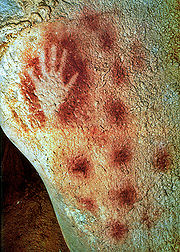
Pech Merle
Encyclopedia

Cabrerets
Cabrerets is a commune in the Lot department in south-western France.The village of Cabrerets derives its name from cabre, meaning goat in the Occitan language.-Geography:...
in the Lot département
Lot (département)
Lot is a department in the southwest of France named after the Lot River.- History :Lot is one of the original 83 departments created during the French Revolution on March 4, 1790. It was created from part of the province of Languedoc. In 1808, some of the original southeastern cantons were...
of the Midi-Pyrénées
Midi-Pyrénées
Midi-Pyrénées is the largest region of metropolitan France by area, larger than the Netherlands or Denmark.Midi-Pyrénées has no historical or geographical unity...
region in France
France
The French Republic , The French Republic , The French Republic , (commonly known as France , is a unitary semi-presidential republic in Western Europe with several overseas territories and islands located on other continents and in the Indian, Pacific, and Atlantic oceans. Metropolitan France...
, about 35 minutes by road east of Cahors
Cahors
Cahors is the capital of the Lot department in south-western France.Its site is dramatic being contained on three sides within an udder shaped twist in the river Lot known as a 'presqu'île' or peninsula...
. It is the home of one of the few prehistoric
Pre-historic art
In the history of art, prehistoric art is all art produced in preliterate, prehistorical cultures beginning somewhere in very late geological history, and generally continuing until that culture either develops writing or other methods of record-keeping, or it makes significant contact with another...
cave painting
Cave painting
Cave paintings are paintings on cave walls and ceilings, and the term is used especially for those dating to prehistoric times. The earliest European cave paintings date to the Aurignacian, some 32,000 years ago. The purpose of the paleolithic cave paintings is not known...
sites in France which remain open to the general public. Extending for more than a mile from the entrance are caverns the walls of which are painted with dramatic murals dating from the Gravettian
Gravettian
thumb|right|Burins to the Gravettian culture.The Gravettian toolmaking culture was a specific archaeological industry of the European Upper Palaeolithic era prevalent before the last glacial epoch. It is named after the type site of La Gravette in the Dordogne region of France where its...
culture (some 25,000 years B.C.) Some of the paintings and engravings, however, could date from the later Magdalenian
Magdalenian
The Magdalenian , refers to one of the later cultures of the Upper Paleolithic in western Europe, dating from around 17,000 BP to 9,000 BP...
era (16,000 years B.C.)
This area once had a great river flowing through it, cutting underground channels which were later used by humans for shelter and eventually for mural painting.
The walls of seven of the chambers at Pech Merle have fresh, lifelike images of a woolly mammoth
Woolly mammoth
The woolly mammoth , also called the tundra mammoth, is a species of mammoth. This animal is known from bones and frozen carcasses from northern North America and northern Eurasia with the best preserved carcasses in Siberia...
http://www.donsmaps.com/images3/mammothpechmerle.jpg, spotted horseshttp://www.judeart.com/Dscn0017.jpg, single colour horses, bovids, reindeer, handprints, and some humans. Footprints of children, preserved in what was once clay, have been found more than half a mile underground. Within a six mile radius of the site are ten other caves with prehistoric art of the Upper Palaeolithic period, but none of these are open to the public. During the Ice Age
Ice age
An ice age or, more precisely, glacial age, is a generic geological period of long-term reduction in the temperature of the Earth's surface and atmosphere, resulting in the presence or expansion of continental ice sheets, polar ice sheets and alpine glaciers...
the caves were very probably used as places of refuge by prehistoric peoples when the area had an Arctic climate, very cold temperatures, and native animal species very different from those of the present day. It is supposed that, at some point in the past, rain and sliding earth covered the cave entrances providing an airtight seal until the 20th century. The cave at Pech Merle has been open to the public since 1926.
Visiting groups are limited in size and number so as not to destroy the delicate artwork with the excessive humidity, heat and carbon dioxide
Carbon dioxide
Carbon dioxide is a naturally occurring chemical compound composed of two oxygen atoms covalently bonded to a single carbon atom...
produced by breathing.


